Fatma Akinçi
In her video Zilgit, the Turkish artist from Kurdistan Fatma Akinçi approaches the handling of forms of expression that can be understood as emotional articulations that occupy a border area between linguistic and non-verbal communication. The word Zilgit means, in a free translation, intensive tongue-beating and denotes a mode of expression that is widely spread in large areas of the Arabic-Islamic world, and which is almost exclusively practiced by women. The Zilgit is made use of in moments of great joy, for example, at weddings, or of great sorrow, at funerals, etc.. It is a code that is employed to express intense emotions.
The video from 2003 shows the artist squatting on a hill, which has a view of Batman, the Kurdish hometown of the protagonist. After a few seconds of quietly observing the city, the young woman stands up and shouts the traditional Zilgit towards the valley where it seems to fade out without being heard by anyone. The scene is shown in a loop, through which the evocative potential of the continuously repeated cry is increased by the reduced action of the scene; only a strong wind accompanies the situation. The emotional context, in which the Zilgit is normally expressed seems to be completely erased. At the same time, the cry is seen here as a complex political and critical gesture. Read culturally, the Zilgit can be understood as a reduced mode of expression of women in traditional Islamic societies, through which it could at least be possible to have a verbal presence in the public space.
Through her exposed position, on one of the tallest hills around Batman, Akinçi avoids the traditional setting of the cry. The challenging gesture that reaches out over the entire valley seems to be a provocative critique of the socially sanctioned role of the woman. This impression is enhanced by the artists western clothes, whereas in the city of Batman, traditional dress and headdress are still seen as constitutive features of the woman. The complex questioning of the social and cultural patterns that Akinçi shows in Zilgit, attains its strength through the decontextualisation of the traditional code, the cry.
Akinçi describes the meaning of the loop, the continuous repetition of the cry in the video as an important aspect of her work. The repetition here stands as an image of the insistent power, with which the younger generation of artists questions the cultural and social status quo.
By Felix Ruhöfer, translated by Eva May
|









